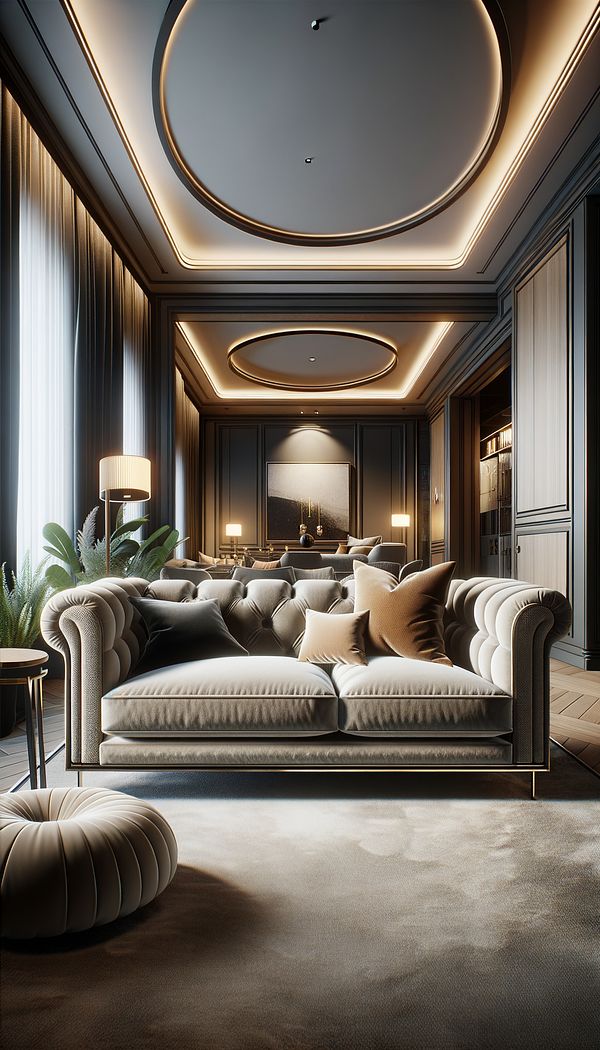What is a Récamier?
A Récamier is a type of chaise longue featuring a high, curved headrest and a lower footrest without a backrest.
Description
The Récamier, named after the 18th-century French socialite Juliette Récamier, is a sophisticated piece of furniture that blends comfort and elegance. Unlike traditional chaise longues, the Récamier distinguishes itself with its unique structure - it features a high, curved headrest at one end and a lower footrest at the opposite end but lacks a backrest along its length. This design choice not only makes it an appealing focal point in a room but also serves a functional purpose by facilitating a reclined seating position that's both comfortable and ergonomically supportive. The Récamier can be upholstered in a variety of materials, including fabrics and textiles, and embellished with decorative elements to complement different interior design styles.
Traditionally, the Récamier is found in more formal spaces like living rooms, libraries, or bedrooms, where its elegant form can fully contribute to the room's aesthetic appeal. However, contemporary interpretations of the Récamier have adapted it for broader applications, ranging from casual lounging to an inviting reading nook. This versatility, combined with its storied history, makes the Récamier a cherished piece for both interior design aficionados and homeowners seeking a touch of classical elegance.
Usage
The Récamier might be used as a chic, standalone piece in a minimalistic living room, providing an eye-catching spot for relaxation. In a more traditional setting, it could be paired with complementary furnishings like side tables and floor lamps to create a cozy, inviting reading corner. Designers also incorporate the Récamier in bedroom decor, placing it at the foot of the bed as an elegant and functional accessory.
FAQs
-
What differentiates a Récamier from a typical chaise longue?
A Récamier is distinct for its high, curved headrest and lower footrest, with the absence of a backrest, unlike a typical chaise longue that usually features a backrest along its length.
-
Can a Récamier be customized?
Yes, like most furniture pieces, a Récamier can be customized in terms of upholstery material, color, and detailing to fit various interior design preferences.
-
Is the Récamier suitable for all types of living spaces?
While traditionally associated with more formal or classic spaces, the contemporary variations of a Récamier can fit a wide range of living spaces, from minimalist to more eclectic interiors.
Practical Application
To effectively incorporate a Récamier into your interior design, consider its placement carefully. It should be positioned in a way that highlights its unique shape and features, ideally in a spot where it can serve as a functional and decorative element without obstructing the flow of the room. Pairing it with the right accessories, such as throw pillows or a chic side table, can further enhance its elegance and utility.
-
Furniture Types599 articles
-
Decorative Objects240 articles
-
Decorating Principles & Elements330 articles
-
Textiles & Upholstery252 articles
-
Williamsburg StyleWilliamsburg Style is a blend of colonial design aesthetics with modern functionality.
-
Glastonbury ChairThe Glastonbury Chair is a wooden folding chair of medieval English design.
-
BakeliteBakelite is an early form of plastic known for its durability and heat resistance.
-
CredenzaA credenza is a type of sideboard or buffet typically used in dining rooms for serving food, displaying serving dishes, or as an additional storage space.
-
CorduroyCorduroy is a fabric distinguished by its textured, ribbed appearance and velvety feel.
